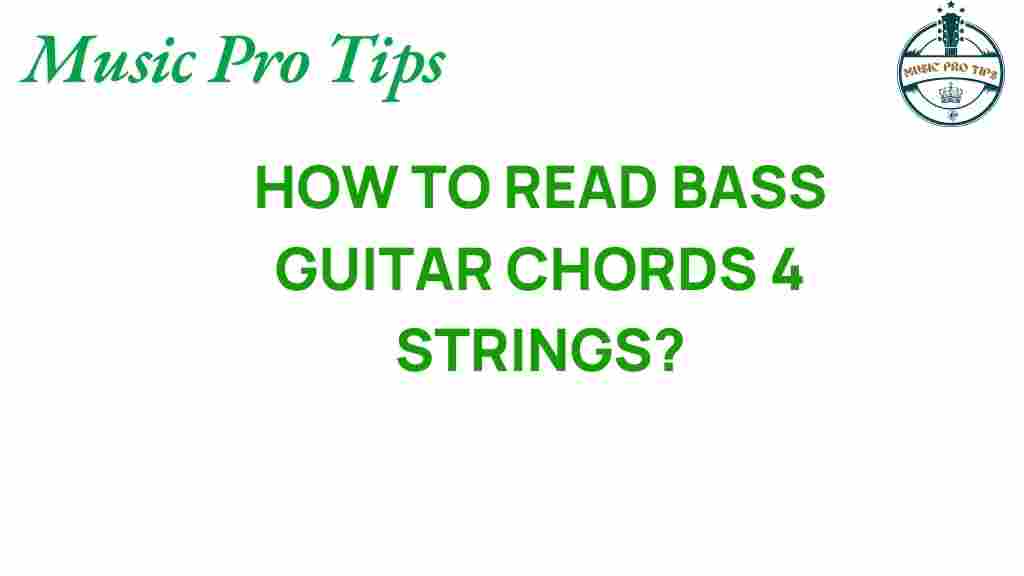Unlocking the Secrets: How to Read Bass Guitar Chords on 4 Strings
As a bassist, understanding how to read bass guitar chords is essential for enhancing your musicianship and navigating through various musical styles. Whether you’re a beginner or an experienced player, mastering the art of interpreting chords will allow you to create compelling bass lines and add depth to your music. This article dives into the intricacies of bass guitar chords, offering insights into music theory, notation, and practical tips for learning.
Understanding the Basics of Bass Guitar and Chords
The bass guitar is a four-stringed instrument that plays a crucial role in the rhythm section of any musical ensemble. While it may seem straightforward, the bass guitar holds a wealth of complexity when it comes to chords and bass lines. Here’s what you need to know:
- Strings and Tuning: The standard tuning of a bass guitar is E1, A1, D2, G2. Familiarizing yourself with these notes is the first step in reading chords.
- Chord Structure: Chords are built from notes stacked in intervals. A basic understanding of music theory is necessary to grasp how these chords are formed.
- Notation Systems: Learning how to read musical notation is vital for any bassist. Standard notation, tablature, and chord charts are common ways to express bass guitar chords.
The Importance of Music Theory in Learning Bass Guitar Chords
Music theory provides the foundation for understanding how chords function within a piece of music. For bass players, a solid grasp of music theory is crucial for creating rhythmic and harmonic support. Here are some key concepts:
- Intervals: The distance between two notes. Common intervals include major and minor thirds, perfect fifths, and octaves.
- Chord Types: Chords can be major, minor, diminished, augmented, and more. Each type has a unique sound and function in music.
- Scale Degrees: Each note in a scale has a specific degree, which helps in identifying the chord tones in a scale context.
Step-by-Step Process to Read Bass Guitar Chords
Now that we’ve established the foundation, let’s explore how to read bass guitar chords effectively.
Step 1: Learn the Chord Shapes
Start by familiarizing yourself with basic chord shapes on the bass guitar. Here are some common shapes:
- Major Chord: Consists of the root, major third, and perfect fifth. For example, a C major chord includes C (root), E (major third), and G (perfect fifth).
- Minor Chord: Comprises the root, minor third, and perfect fifth. For instance, A minor includes A (root), C (minor third), and E (perfect fifth).
- Seventh Chord: Adds a seventh note to the triad. For a dominant seventh chord, you would include the root, major third, perfect fifth, and minor seventh.
Step 2: Understand Chord Notation
Chord notation is how you’ll encounter chords in sheet music and tablature. Here’s a breakdown of common notations:
- Chord Symbols: Typically written above the staff (e.g., C, Am, G7).
- Tablature: A visual representation of the strings and frets that shows you where to place your fingers.
Step 3: Practice with Common Progressions
Once you’re comfortable with chord shapes and notation, practice playing common chord progressions. This will solidify your understanding and improve your ability to read. Here are a few popular progressions:
- I-IV-V: This progression uses the first, fourth, and fifth chords of a key (e.g., C-F-G in the key of C).
- ii-V-I: A common jazz progression (e.g., Dm-G-C in the key of C).
- I-vi-ii-V: A classic progression used in many songs (e.g., C-Am-Dm-G in the key of C).
Step 4: Incorporate Rhythm and Groove
As a bassist, rhythm is just as important as harmony. Practice playing bass lines that incorporate these chords while focusing on rhythm. Work on your timing and feel to lock in with the drummer and other musicians.
Step 5: Experiment with Different Styles
Different musical genres utilize bass guitar chords in various ways. Experiment with playing in styles such as:
- Rock: Focus on driving bass lines.
- Jazz: Emphasize chord changes and improvisation.
- Funk: Incorporate syncopated rhythms and slap techniques.
Troubleshooting Tips for Reading Bass Guitar Chords
Learning to read bass guitar chords can be challenging. Here are some tips to overcome common issues:
- Struggling with Timing: Use a metronome to practice your timing and play along with backing tracks.
- Difficulty with Finger Placement: Take your time to build muscle memory. Slow practice will help you develop accuracy.
- Confusion with Notation: Break down complex pieces into smaller sections. Practice each part until you feel comfortable.
Resources for Further Learning
To enhance your understanding of bass guitar chords, consider exploring the following resources:
- Online courses that focus on bass guitar musicianship.
- Books on music theory that cater to bass players.
- YouTube tutorials that break down popular bass lines and chord progressions.
Conclusion: Mastering Bass Guitar Chords
Unlocking the secrets of how to read bass guitar chords is an invaluable skill for any aspiring bassist. By understanding music theory, notation, and the practical application of chords in various styles, you can significantly improve your musicianship. Remember, the key is consistent practice and patience. Embrace the journey of learning, and soon, you’ll be crafting impressive bass lines that elevate your music.
With dedication and the right resources, reading bass guitar chords will become second nature, allowing you to express yourself creatively through this wonderful stringed instrument.
This article is in the category Theory and created by MusicProTips Team

1 thought on “Unlocking the Secrets: How to Read Bass Guitar Chords on 4 Strings”